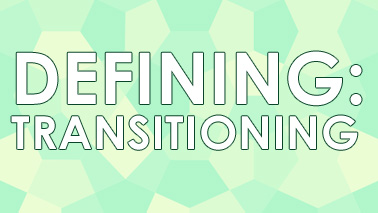
Defining: Transitioning
June 6, 2018 Jamey Alea 0 Comments
DEFINE IT:
Many transgender people experience some form of gender dysphoria. Feeling ill at ease with one’s body and how others perceive it often leads to some sort of desire to change that. The dictionary definition of transition is “the movement, passage or change from one state to another.” Gender transition is the same. Transitioning is all about leaving behind the things about yourself and your gender that don’t feel right, and then feeling empowered to embrace only what does feel right.
EXPLAIN IT:
Trans people, like all people, are unique! We all have different relationships with our bodies and genders, we all experience gender dysphoria differently, and, as a result, our transitions all look different.
Transition is a very personal thing. Some people “finish” transitioning but for many people, it’s an active process. There are also two distinct kinds of transition: social and medical.
Social transition is related to how someone presents themself, how they want to be perceived by others, and how they feel comfortable being referred to. Social transition can refer to things like: coming out publicly as trans, changing one’s name and/or pronouns, or changing things about one’s appearance such as hair, clothing, or makeup.
Medical transition is related to the medical procedures that one can undergo in order to more permanently change their body. One of the common aspects of this is hormone replacement therapy (HRT), which essentially involves taking either estrogen or testosterone, as appropriate. There are also a number of different surgeries one can choose to undertake—or opt out of! A mastectomy (“top surgery”) is the most common one for transmasculine people. On the other side of the coin, there are several surgeries available for transfeminine people, including vaginoplasty, orchiectomy, breast implants, facial feminization surgery, and others.
While these surgeries are often what people think about when they hear the phrase “gender transition,” they are often not the most significant part of the transition process, and many people choose to opt out of surgery entirely. That’s why a lot of folks like to refer to them as “gender affirming surgeries” — surgery doesn’t make a trans woman into a woman. She was already a woman! Surgery may just help her feel better about herself and her body.
DEBUNK IT:
“So Jamey, have you had the surgery yet?”
LET ME STOP YOU RIGHT THERE — and explain to you everything that’s wrong with this horrible (but all too common) question!
First and foremost, asking someone personal questions about their transition is extremely rude. Do you normally go around asking people invasive questions about their genitals? Then why are you doing it just because you found out someone is trans?
Additionally, the question doesn’t even really make sense! Medical transition involves a series of surgeries and each individual has to decide for themselves which ones they want to undergo. “The surgery” — the idea that there’s one single “gender reassignment surgery” that’s the end-all-be-all of transition — is a myth.
“If someone doesn’t do a ‘full transition’, they’re not really trans.”
Definitely not! Deciding whether or not to transition and what aspects of transitioning one feels comfortable with is intensely personal! Some people can’t undergo medical transition due to medical complications. Many non-binary people don’t feel comfortable doing a “full” transition because they don’t really feel like the “opposite” gender either. (That said, some non-binary people do choose to medically transition, so the notion that non-binary people never have to transition is also a myth!)
On top of that, what does the phrase “full transition” even really mean? Many people find that transitioning socially is enough for them and that they don’t need to physically change their body in order to be happy living as their true gender. The point is that there are lots of reasons that someone may pick and choose only certain aspects of transition—and once they have transitioned to the extent they feel comfortable with, that’s what a “full transition” looks like for them! That’s completely valid and doesn’t make anybody any less trans.
(This article was originally published on My Kid Is Gay.)